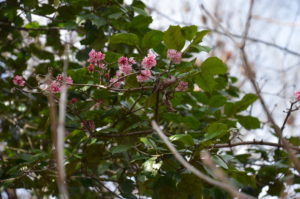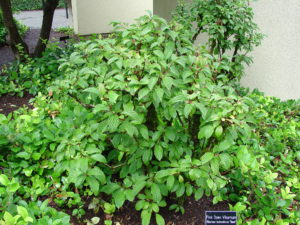Viburnum x bodnantense (cross between V. farreri and V. grandiflorum) is a hybrid viburnum that was developed at Bodnant Garden in Wales in 1934-1935 (USDA zones 5-9). Also called Pink Dawn, this shrub is cherished for exceptional three-season interest – fragrant pink flowers in spring, clean, blemish-free summer foliage, and above average fall color.
‘Dawn’ is a cultivar that features rosy-pink flowers. The shrub grows upright in a multi-stemmed, vase shaped habit. It typically matures to 8-10 feet tall and 4-6 feet wide. Toothed, 2-4 inch long narrow-ovate leaves emerge in spring with bronze tints on leaf edges; leaves mature to deep green hues. Foliage turns an attractive burgundy-red in fall. Flowers give way to red berries (drupes) that ripen to black in the fall.
Its showy flowering habit is reason enough to plant this early flowering viburnum, in many years blooming alongside winter-flowering winterhazels (Corylopsis), fragrant honeysuckle (Lonicera fragrantissima) and paperbush (Edgeworthia). In zone 6, the reddish buds swell and open into the clusters of long-lasting, clear pink, tubular flowers. Summer foliage is dark green and branches are cinnamon colored.
Dawn viburnum grows in average, medium moisture, well-drained, moderately acidic soil in full sun to partial shade. Expect greater numbers of flowers in full sun and less so in shady landscape areas. Avoid soils that are droughty or soppy wet. Site the shrub in a protected location to help protect spring flowers to hard freezes. Fertilize and mulch shrub(s) in early spring. Prune the shrub immediately after spring flowering is over.
Dawn viburnum may be planted as a foundation or plant several for a hedge or privacy screen. Cultivar named ‘Charles Lamont’ grows 1-2 feet taller but is not as wide. All other traits similar to ‘Dawn’.
Habit is upright-spreading with stiff, coarse branching. Grows 10-12′ tall and about 2/3 as wide. Flowers are slightly larger and a brighter pink than ‘Dawn’ and have yellow anthers. Flowers at a very young age and thought to be more free flowering. The leaves are also larger than that of ‘Dawn’.
No serious insect or disease problems trouble this shrub viburnum. Late winter/early spring flowers are susceptible to frost damage.
Dawn viburnum has received the Royal Horticultural Society Award Of Merit.



 Posted in
Posted in 
